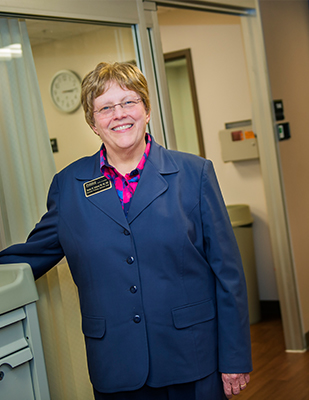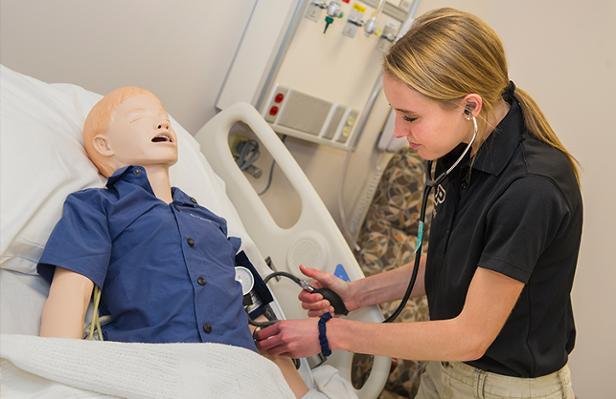Larger than life
Simulation center brings clinical experience to the classroom
Written by Story by Elizabeth K. Gardner

Anyone who has visited a modern hospital would find the newly remodeled Center for Nursing Education and Simulation familiar. Six patient rooms contain furniture, decor, equipment and carts of medical supplies matching exactly what is expected. The familiarity of the center, however, is part of what makes it extraordinary. It hides state-of-the-art technology that works in concert with the hospital-room feel to create realistic simulations of clinical experiences — simulations that often offer more challenging experiences and greater variety than standard student clinical practice.
The patients that reside in Purdue’s Center for Nursing Education and Simulation (CNES) are high-fidelity simulators, realistic human manikins that speak, have accurate heart, lung and bowel sounds, pulses and programmable vital signs, and respond to care. The rooms are wired with cameras, microphones and receivers in the ceiling, and one-way mirrors allow instructors in control rooms to guide the simulations without detracting from the realism of the setting.
“We want the students to be immersed in a hospital room environment,” says Amy Nagle, a continuing lecturer in the Purdue School of Nursing who uses simulations in the courses she teaches. “They look and feel real, but they also are a safe environment where mistakes don’t cause any real harm, which frees the student from some of the stress that could inhibit learning. The simulations prepare students to confidently begin their clinical rounds at hospitals.”
Simulation tools available
- Three adult Laerdal Sim Man high-fidelity simulator manikins
- One infant Laerdal Sim Baby high-fidelity simulator manikin
- One child Laerdal pediatric high-fidelity simulator manikin
- One pregnant mother Gaumard maternity simulator Noelle S 575 and an interactive newborn HAL high-fidelity simulator pair
- 10 static manikins
Expanded experiences
Purdue Nursing faculty members control the patients’ responses and vital signs through a laptop, and sometimes speak for them through microphones. They record and observe the students, who are able to experience and navigate rare or difficult situations they might never encounter or might not be permitted to treat as students in clinical practice.
“The high-tech simulations allow us to push students’ comfort zones,” says Pamela Aaltonen, associate professor and associate head of the School of Nursing. “In a simulation we can let things unfold, even if they are going wrong. If a student were going to give the wrong medication to a real patient, we would step in and prevent it, but in a simulation we can show what would happen.”
The simulations offer students the opportunity to independently manage patient care and make decisions in scenarios ranging from cardiac or respiratory arrest to sepsis and shock. Students can even experience the processes of normal and complicated childbirth — a pregnant mother manikin simulator can go through labor and give birth.
After each simulation, there is a debrief session when a student gets to process what happened, Nagle says. The student is able to watch video of themselves performing the simulation and to discuss what went well and what could have been done differently.
That review and processing is critical to a student’s understanding and retention of what they have learned,” she says. “The lessons learned from simulations really stay with the students throughout their career.
The future of nursing education
Results of a study by the National Council of the State Boards of Nursing suggest that substituting high-quality simulation experiences for up to half of traditional clinic hours produced comparable educational outcomes and graduates “ready for clinical practice.”
According to the study, an increase in the use of simulations is expected to relieve some of the strain on nursing programs. Competition among programs for limited clinical sites, faculty shortages and patient safety initiatives that decrease the number of students allowed on a patient unit or limit student activities have recently begun to tax the programs. The new obstacles add to existing challenges of short patient stays, disparities in learning experiences, a decrease in nurse-to-patient ratios and the amount of time instructors are able to spend supervising students.
“We are already seeing simulation becoming a much larger part of a student’s education,” Aaltonen says. “The center is a tremendous resource for Purdue, especially as we double the size of our undergraduate class and work to meet the national demand for highly trained nurses.”
Purdue School of Nursing students currently spend one to two weeks a semester in simulations in comparison to 12 weeks in clinical practice, and there are plans to increase the amount of simulation time, she says. To better accommodate this increased demand, the school boosted the center's coordinator position to full-time status. Benjamin Melanowski, a registered nurse, joined the school as coordinator of the center in January. He is a graduate of the Purdue accelerated second degree nursing program and most recently practiced with the Indian Health Services in Winslow, Arizona.
“Simulations also have an advantage over traditional clinical time in terms of standardizing student education,” Aaltonen says. “Simulations allow us to make sure important scenarios are covered in every student’s education, so that they have the critical thinking skills and judgment to handle any situation they may face.”
A center for every stage of education

A $1 million University grant supported the renovation of the center in Johnson Hall, which doubled the number of simulation rooms and allowed the design to more closely resemble a real hospital wing. In addition, the funding supported the creation of three control rooms and added three high-fidelity manikin simulators. The renovated space also includes a computer lab, debriefing rooms and multiple group work areas for collaborative learning projects. In honor of her leadership and contributions to the school, the student interaction space at the entrance to the center is named The Dr. Pamela Aaltonen Student Learning and Engagement Space.
Beginning in their freshman year, students become familiar with the space. During the sophomore health assessment course, students work with manikins to practice listening to heart and lung sounds, taking blood pressure measurements and other basic assessments. In their junior year, students use the simulations both semesters for multiple experiences in their medical/surgical course and obstetrics course. In their senior year, students work with the pediatric simulators, and they practice directing the care of increasingly complex patients.
Kailey Cadogan, a senior in the School of Nursing and CNES senior scholar who assists faculty and students at the center, says the simulations have been an important part of her education.
“At first it is just a manikin, but then you get into it and it becomes a real scenario,” she says. “You are swept up in it and feel the same intensity and anxiety as when working with a real patient. There is the safety net that it is only a simulation and a mistake isn’t going to hurt someone, but you don’t feel that in the moment. You give it your all.”
